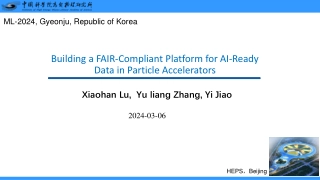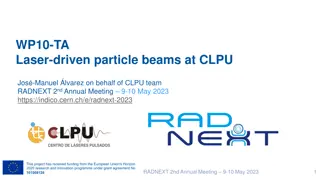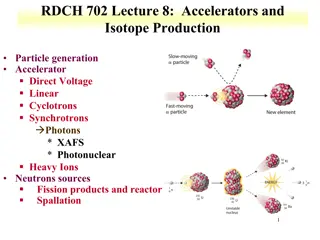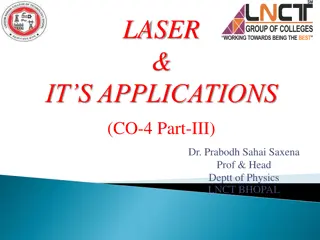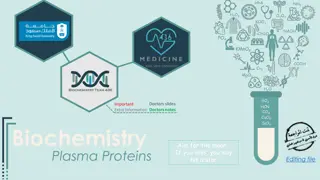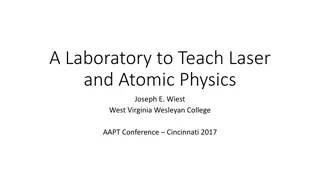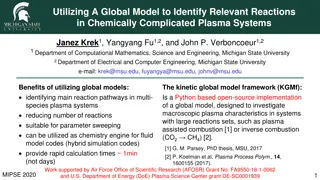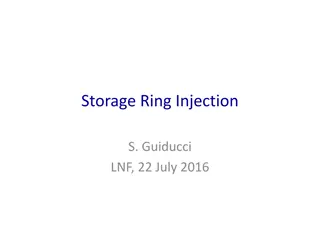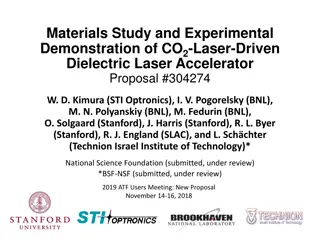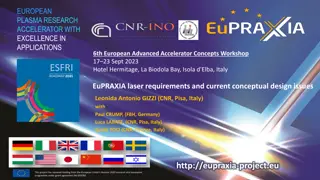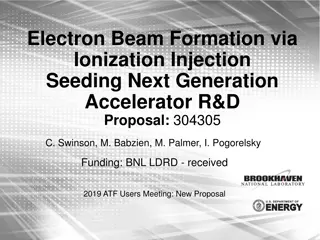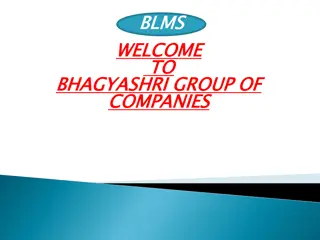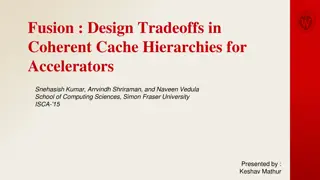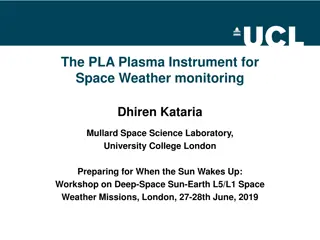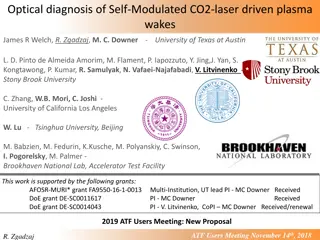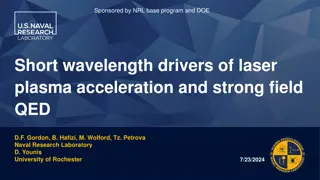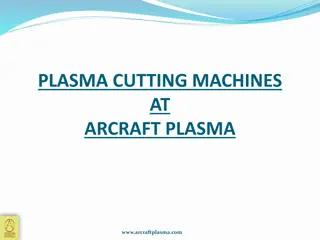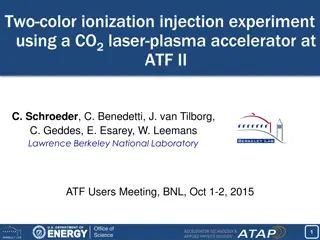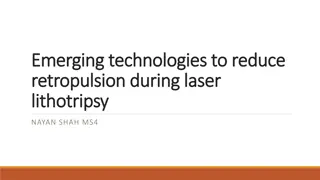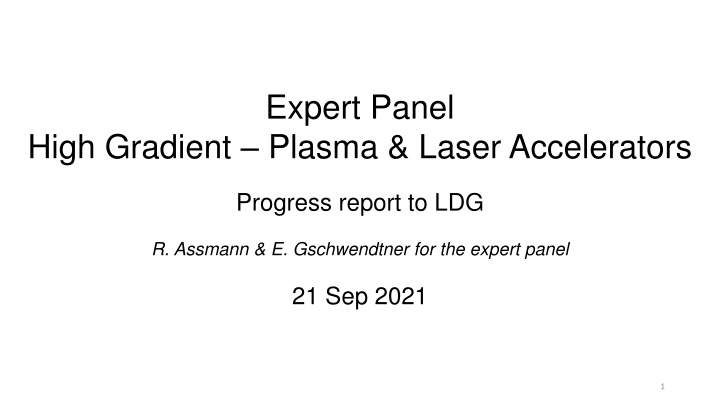
Progress in High Gradient Plasma & Laser Accelerators Panel Report
The expert panel's progress report outlines a roadmap for high-energy physics applications over the next 30 years, emphasizing R&D needs, key stakeholders, and consultation processes. Advanced accelerator technologies, such as laser/electron/proton-driven systems, have shown promising energy and quality advancements. However, challenges like demonstrating positron schemes in plasma accelerators and calculating staging designs for high energy remain. The panel aims to address feasibility issues through coordinated studies and technical milestones.
Uploaded on | 1 Views
Download Presentation

Please find below an Image/Link to download the presentation.
The content on the website is provided AS IS for your information and personal use only. It may not be sold, licensed, or shared on other websites without obtaining consent from the author. If you encounter any issues during the download, it is possible that the publisher has removed the file from their server.
You are allowed to download the files provided on this website for personal or commercial use, subject to the condition that they are used lawfully. All files are the property of their respective owners.
The content on the website is provided AS IS for your information and personal use only. It may not be sold, licensed, or shared on other websites without obtaining consent from the author.
E N D
Presentation Transcript
Expert Panel High Gradient Plasma & Laser Accelerators Progress report to LDG R. Assmann & E. Gschwendtner for the expert panel 21 Sep 2021 1
Reminder: Setup and Persons Involved, Mandate Mandate: Expert Panel High Gradient: Plasma and Laser Accelerators Follow-up Panel to Europ. Strategy for Particle Physics Panel proposes roadmap for use in Particle Physcis Develop a long-term roadmap for the next 30 years towards a HEP collider or other HEP applications. Develop milestones for the next 10 years taking explicitly into account the plans and needs in related scientific fields as well as the capabilities and interests of the stakeholders. Establish key R&D needs matched to the existing and planned R&D facilities. Panel members: Chair: Ralph Assmann (DESY/INFN) Deputy Chair: Edda Gschwendtner (CERN) Kevin Cassou (IN2P3/IJCLab), Sebastien Corde (IP Paris), Laura Corner ( Liverpool), Brigitte Cros (CNRS UPSay), Massimo Ferarrio (INFN), Simon Hooker (Oxford), Rasmus Ischebeck (PSI), Andrea Latina (CERN), Olle Lundh (Lund), Patric Muggli (MPI Munich), Phi Nghiem (CEA/IRFU), Jens Osterhoff (DESY), Tor Raubenheimer (SLAC), Arnd Specka (IN2PR/LLR), Jorge Vieira (IST), Matthew Wing (UCL). Give options and scenarios for European activity level and investment. Define deliverables until the next European strategy process in 2026, which allow deciding on the continuation of this R&D line for HEP. Elaborate consultation process with 231 registered participants, 3 townhall meetings, > 60 talks and inputs. Panel associated members: Cameron Geddes (LBNL), Mark Hogan (SLAC)), Wei Lu (Tsinghua U.) , Pietro Musumeci (UCLA) 2
Expert Panel Assessment General considerations Advanced accelerators have made important progress in demonstrating key aspects of those technologies: energy and quality for laser/electron/proton driven Rapid progress in underlying technologies, e.g. lasers, feedbacks, nano-control, manufacturing, Feasibility of a collider remains to be proven: E.g. scheme for positrons in plasma accelerators still to be demonstrated on paper. Staging designs for high energy remain to be calculated in detail and with all elements, including tolerances, length and cost scaling. Repetition rate issues and efficiency approach to be investigated in detail. Therefore: 1st coordinated study to address feasibility required (layout, theory and simulation). Complemented by selected technical milestones of relevance. 3
Common coordinated pre-CDR study for particle physics (2 MCHF/year personnel funding, 2022 - 2026, 5 years) 2022 - Setup of simulation tools for electron case studies (multi-stage) Electronbeam physics and simulation models with certain approximations for 2 or more stages, all interconnections, in/out- coupling, for 15 GeV and 190 GeV, including synchrotron radiation and collective effects Positronbeam physics and simulation models with certain approximations for 2 or more stages, all interconnections, in/out- coupling, for 15 GeV and 190 GeV, including synchrotron radiation and collective effects Multi-stage electron accelerator from 175 GeV to 190 GeV, including full lattice, in/out-coupling, all magnetic elements, correctors, diagnostics, collective effects, synchrotron radiation, estimate of realistic performance, estimate of realistic footprint, estimate of realistic benefits in cost and size, understanding of scaling with beam energy for different technologies (laser-driven, electron-driven, proton-driven, DLA/THz). See talk Jorge Vieira 2023 - Setup of simulation tools for positron case studies (multi-stage) See talk Jorge Vieira 2024 - DELIVERABLE: Report electron high energy case study See talk Edda Gschwendtner 5
Common coordinated pre-CDR study for particle physics (2 MCHF/year personnel funding, 2022 - 2026, 5 years) 2024 - DELIVERABLE: Physics Case of an Advanced Collider Report from common study group with particle physicists on physics cases of interest at the energy frontier (e+e- collider, gg) and at lower beam energies (e- g collider, dark matter search, ) Multi-stage positron accelerator from 175 GeV to 190 GeV, including full lattice, in/out-coupling, all magnetic elements, correctors, diagnostics, collective effects, synchrotron radiation, estimate of realistic performance, estimate of realistic footprint, estimate of realistic benefits in cost and size, understanding of scaling with beam energy for different technologies (laser-driven, electron-driven, proton-driven, DLA/THz). Assessing the low energy regime around 15-50 GeV, achievable performance, foot print and cost, schemes and designs for first particle physics experiments with novel accelerators, needed R&D demonstration topics for low energy design and needed test facilities Assessment of IP issues in an advanced collider with ultra-short bunches, benefits for disruption, possibility for spin polarized beams 2025 - DELIVERABLE: Report positron high energy case study See talk Edda Gschwendtner 2025 - DELIVERABLE: Report low energy study cases for electrons and positrons 2026 - Study of spin preservation and beam-disruption mitigation strategies for a plasma-based collider 6
Common coordinated pre-CDR study for particle physics (2 MCHF/year personnel funding, 2022 - 2026, 5 years) 2026 - DELIVERABLE: Pre-CDR and Collider Feasibility Report Input for decision point of European strategy, brings together work/reports achieved (see earlier). Complemented by report on Technical Readiness Levels (TRL report) for collider components and systems. Preliminary physics case report. Comparison of performance and readiness for different technologies (laser, electron, proton driven plasma, DLA/THz) for a possible focus on the most promising path for particle physics. Design of a staging experiment. Report on intermediate steps and need for a dedicated facility. Project plan for a CDR of an advanced collider. 7
Input and findings: 56 proposed milestones and deliverables for R&D until 2037. To be discussed further and prioritized in next step of the roadmap process. 9
Evaluation points No. Criterion Sub-criterion Impact on Future Particle Physics Infrastructures 1 0 - 6 Importance for achieving required performance parameters (integrated luminosity, background, ) a 0, 1, 2 Importance for removing potential road-blocks, building intermediate demonstration steps b 0, 1, 2 Importance for sustainability (energy consumption, facility size, environmental impact, ...) c 0, 1, 2 Feasibility of the proposed R&D project 2 0 - 4 a Scientific & technical readiness 0, 1, 2 b Existing funding support 0, 1, 2 3 Strategic importance 0 - 6 a Relevance for next European Strategy decisions 0, 2, 4 b Importance for national, regional and European strategies 0, 1, 2 10
Expert Panel Identified 9 Draft Technical Milestones until Next Strategy Update in 2027 Panel used the input received (many thanks again), evaluation criteria and expert assessment We tried to identify milestones of importance for particle physics aimed to address needs and to build trust Milestones should be detailed, realistic and achievable by 2026 Milestones should convince particle physics in 2027 that our field achieved the agreed goals and is on a good track towards demonstrating a collider and intermediate particle physics experiments Will present draft milestones in the following: comments and suggestion for final process are invited 11
Particle Physics Interest See Collider Goals provide e-and e+beams in the TeV energy regime and produce > 1034cm-2s-1luminosity from expert panel interim report How and when can we arrive at readiness for for high energy particle physics? 12
Milestones Plasma Beam Sources (towards collider needs) Topic Funding (material budget) Needed funding Milestones to be achieved by 2026 Far term goal Compact, stable electron beam source for plasma accelerators (scalable to collider rep rate of 15 kHz) Electron beam with 50-250 MeV, 10-100 Hz, sub-micron emittance, 30-100 pC 15 kHz, >500 pC, <100nm emittance, fs bunch Compact, stable positron beam source for plasma accelerators (possibly scalable to collider rep rate of 15 kHz) Positron beam with 10 MeV, 5-10 micron emittance, 4% energy spread, 1 pC 15 kHz, >500 pC, <100nm emittance, fs bunch See talk Gianluca Sarri 13
Milestones Plasma Accelerator Module (towards collider needs) Topic Milestones to be achieved by 2026 Far term goal Funding (material budget) Needed funding High repetition rate plasma accelerator module (scalable to collider rep rate of 15 kHz) At least 1 kHz characterized, robust lifetime (>1e9 shots), only plasma cell, w/o full rep rate beam test, include cooling - power handling assessment Beam demonstration of high efficiency PWFA module, excited by a train of drivers 15 kHz repetition rate High efficiency, electron-driven plasma accelerator module (scalable to 50% efficiency in energy transfer) High charge, high quality plasma accelerator module, driven by laser pulses (scalable to 1 nC) 50% transfer efficiency from stored energy beam driver to stored energy beam witness accelerator module with 1 nC high quality beam (outcome feasibility study) Energy >500 MeV, charge 500 pC, sub % energy spread, micron normalized emittance (tests including LWFA injection) Several metres long prototype with required plasma density and stability. Scalable plasma source (rowards several metres length) 10s to 100s metres of plasma source 14
Milestone Plasma Laser Driver (towards collider needs) Topic Funding (material budget) Needed funding Milestones to be achieved by 2026 Far term goal High repetition rate, high peak power laser Demonstration of kW average power (e.g. 100Hz, 10J, <100fs or 1kHz, 1J , <100fs or another combination/scheme) Ti:sapp laser pulse 15 kHz rep rate, >100 Tera- Watt, 30% wall plug efficiency 15
Milestone Plasma Spin Polarization (towards collider needs) Topic Funding (material budget) Needed funding Milestones to be achieved by 2026 Far term goal Spin polarized beams for a plasma-based collider (proof of principle) Demonstration of polarized electron beams from plasma with 10-20% polarization fraction Polarization 85% 16
Milestone DLA/THz Accelerator (towards collider needs) Topic Funding (material budget) Needed funding Milestones to be achieved by 2026 Far term goal Scaling of DLA/THz accelerators for high energy Dielectric 10 MeV with increased acceleration length and at least 2 stages massively scalable many stage (1e6) design printed on a chip 17
Complemented by US US Programs Programs See talk Pietro Musumeci Milestones that might be achieved by 2027, in time for next European strategy update (relevant for PP) Facility or Project Funding (material budget, maybe plus pre- invest) Milestones that might be achieved beyond 2027 (relevant for PP) BELLA (LBNL, US) High efficiency multi-kHz lasers at the J level and beyond; operation of a user facility based on multi-kHz LPA; R&D to further improve electron beam quality and stability from LPAs; positron acceleration and staging in plasmas; science experiments using LPA-driven sources of particles and photons; integrated design studies of plasma collider. Commissioning of facility upgrades that deliver 10 GeV electrons and positrons to the experimental area within one plasma period for studies of electron-driven plasma acceleration of positrons Multi-GeV electron staging of two LPA modules with high coupling efficiency and emittance preservation; 10 GeV high-quality electron beams from a single stage; high brightness electron beams from laser-triggered injection; active feedback stabilization of LPA with machine learning/AI techniques; high efficiency multi-kHz lasers to the few hundred mJ level; studies of positron capture and acceleration in plasmas; demonstration of LPA-driven light sources (XUV FEL, gamma-ray Thomson source); conceptual design studies of a plasma-based colliders. Single plasma stage with combined parameters: 10 GeV energy gain of witness bunch in one meter plasma, normalized emittance preservation at few micron level, percent level energy spread and >30% overall energy transfer from drive to witness bunch; Development of ultra-high brightness plasma-based injector with 10's nm emittance as proxy for collider level emittance beams; characterize mechanisms for emittance growth in PWFA and demonstrate mitigations; measurement of plasma target recovery time to inform maximum repetition rate in collider designs; development of single shot ML/AI virtual diagnostics for extreme beams; construction of facility upgrade to deliver 10GeV positrons and electrons to experimental area FACET-II (SLAC, US) See talk Mark Hogan for e+ 18
Complemented by Milestones in Ongoing aimed at other applications (synergy) and funded from other science fields Ongoing Projects Projects Milestones that might be achieved by 2027, in time for next European strategy update (relevant for PP) Feasibility study of LWFA electron source at 100pC level, tunable energy range up to GeV, physics study of positron source from LWFA electrons Funding (material budget, maybe plus pre-invest) 60-100 M Facility or Project Milestones that might be achieved beyond 2027 (relevant for PP) APOLLON (France) none scheduled [potential for demonstration of 10 GeV LWF acceleration module, and 2 stage multi-GeV experiment, effective implementation is limited by insufficient laser beam availability for this type of program] AWAKE (CERN) Demonstrate the seeding of the self- modulation process with an electron bunch. Optimize the process of generation of wakefields using a plasma density step to maintain large wakefields at the GV/m level and accelerate electrons to multi-GeV energies. Demonstrate the acceleration of an electron witness bunch to 10GeV in 10m with control of the incoming normalized emittance at the 10mm-mrad level and percent energy spread. Develop scalable plasma sources 50 100 m long, and demonstrate acceleration in a scalable plasma source (helicon or discharge) to 50 to 100 GeV energies. EuPRAXIA (European, ESFRI project) TDR for plasma electron accelerator, FEL and positron user facility. Report from EU funded preparatory phase project (laser-based site, legal model, financial model, access rules, innovation model). 2029: Electron beam-driven EuPRAXIA FEL at Frascati in operation with users. 2030: EuPRAXIA laser-driven facility operates at several GeV with users. EuPRAXIA laser at 800nm wavelength (few kW) [3]: pulse energy 50- 100J, repetition rate 20-100Hz, pulse duration 50-60fs, energy stability (RMS) 0.6 1%, pointing stability (RMS) 0.1 rad. Two stage, 5 GeV HQ e- bunch, FEL operation. 569 M (110 M secured) 19
Complemented by Milestones in Ongoing aimed at other applications (synergy) and funded from other science fields Ongoing Projects Projects Milestones that might be achieved by 2027, in time for next European strategy update (relevant for PP) Facility or Project Funding (material budget, maybe plus pre- invest) 7 M (6 M secured) Milestones that might be achieved beyond 2027 (relevant for PP) SPARC-LAB (Italy) 1) High efficiency, electron-driven plasma accelerator module, (driven by a train of 4 Drivers, with ramped bunch charge, total charge up to 300 pC, GV/m accelerating gradient, fs scale synchronization). 2) High repetition rate plasma accelerator module(off-line capillary discharge/vacuum system characteriszation at kHz repetition rate) 3) High charge, high quality plasma accelerator module, driven by laser pulses(LWFA module with external electron bunch injection suitable to test also staging configuration with fs scale synchronization) 2023: CLARA Phase 2 + FEBE beamline construction completed. 2024: Beam commissioning and first user access period completed. 2024-2027: user-led science programme with programmatic access: 1) plasma acceleration (beam-driven wakefield, external injection laser- driven wakefield) and structure wakefield acceleration; 2) post- acceleration beam capture and 6D phase-space characterisation; 3) tailored multi-bunch delivery to FEBE for beam-driven acceleration; 4) beam-driven acceleration at 400 Hz. phase 1 : high quality laser-plasma electron injector for staging, 10Hz, 10-50pC, 150-250MeV, 1um emn, conceptual design study for 1 stage > 1 GeV, preparing post 2027 To be defined in the framework of EuPRAXIA@SPARC_LAB collaboration CLARA (UK) 2027+: Demonstration of plasma- driven FEL on FEBE beamline. 33.4 M ( 27.9 M secured) PALLAS (France)10.86M phase 2 : laser driven staging at GeV level, 10Hz level depending of budget possibilty. (8.45M secured) for phase 1 20
Complemented by Milestones in Ongoing aimed at other applications (synergy) and funded from other science fields Ongoing Projects Projects Milestones that might be achieved by 2027, in time for next European strategy update (relevant for PP) Facility or Project Funding (material budget, maybe plus pre- invest) Milestones that might be achieved beyond 2027 (relevant for PP) DESY-KALDERA (Germany) kW-average power drive laser (1J@1kHz) for LPA; application- ready LPA injectior: GeV-scale energy, sub-percent energy spread, kHz level electron beams; pilot-application soft-X-ray FEL; active feedback/feedforward stabilization (including machine learning techniques) Single, beam-driven plasma-booster stage with beam-quaity preservation at 0.1% energy spread, 2 m norm. emittance, 40% overall efficiency at the 1 to 2 GeV energy level and 100 pC witness charge (FEL quality); exploration of plasma physics for the kHz to GHz repetition rate regime; development of high- average power plasma sources; active feedback / feedforward stabilization (including machine learning techniques) DESY- FLASHForward (Germany) Booster stage average power extended to 10 kW level drive beam in ILC-like bunch pattern; application as FEL booster module for FLASH to extend photon science reach DESY-PETRA-IV Plasma injector (The Moon Shot) (Germany) DESY-The Mars Shot (Germany) 6 GeV LPA PETRA-IV injector with sub-1% energy bandwidth-jitter- envelope, 24/7 operation, and up to 3.2 nC / s charge delivery ~10 stage, self-stabilized, scalable plasma accelerator in the 10 - 20 GeV range to drive a hard X-ray FEL and LUXE-style nonlinear QED studies 21
Complemented by Milestones in Ongoing aimed at other applications (synergy) and funded from other science fields Ongoing Projects Projects Milestones that might be achieved by 2027, in time for next European strategy update (relevant for PP) Facility or Project Funding (material budget, maybe plus pre- invest) Milestones that might be achieved beyond 2027 (relevant for PP) ELI (European) EPAC (UK) HZDR (Germany) CLEAR (CERN) CALA (Germany) SCAPA (UK) Your (the missing facility) 22
Conclusion We presented the draft structure of our roadmap high gradient plasma and laser accelerators for particle physics Highest priority: Coordinated feasibility study for high energy physics quite some paper work to be done (minimum requirement: it must work on paper and in simulation). This must be an international, common effort with US and Asia. Report by 2027. Complemented by: Nine detailed technical R&D milestones to be achieved by 2027, in time for the next European stratgey. US program with additional (complementary) milestones. Milestones in ongoing advanced accelerator projects and/or facilities. Here: only quick run through (apologies): Edda will give some detail on some of our roadmap components. 23

